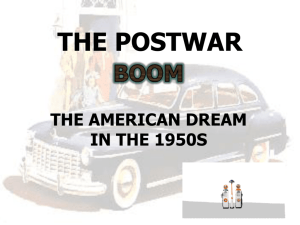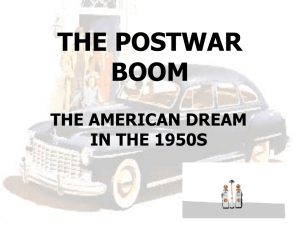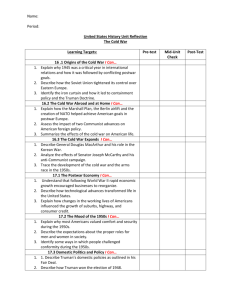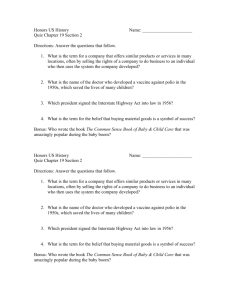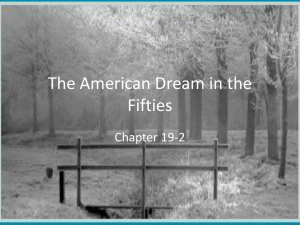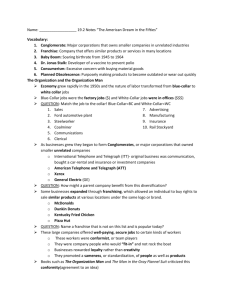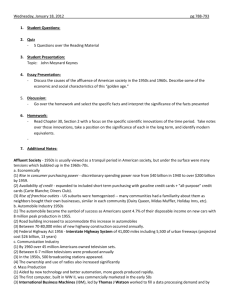THE POSTWAR BOOM
advertisement
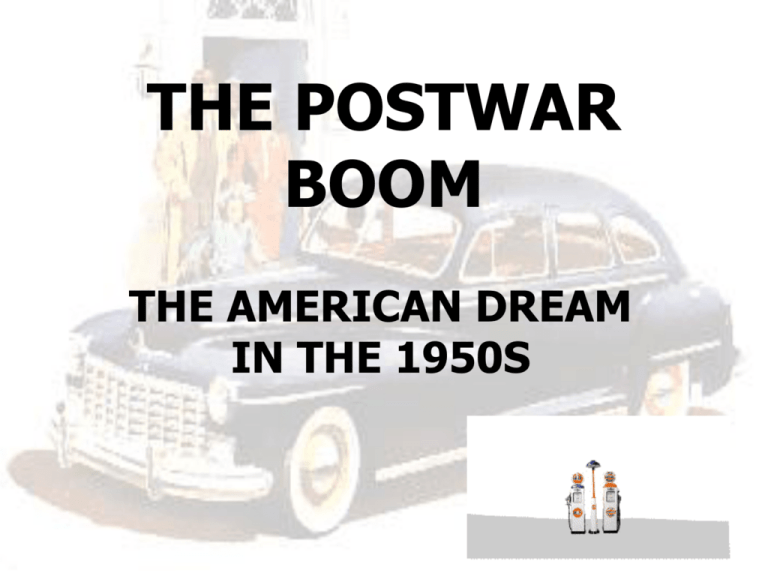
THE POSTWAR BOOM THE AMERICAN DREAM IN THE 1950S THE AMERICAN DREAM IN THE FIFTIES New businesses and technology created opportunities for many Americans were enjoying the highest standard of living in the world Ozzie and Harriet reflected the perfect American family REDEFINING THE FAMILY Things returned to “normal” Men were expected to work Women were expected to stay home and care for the children Divorce rates surged THE SUBURBAN LIFESTYLE 85% of homes were built in suburbs The suburbs were the “American Dream” SUBURBAN AMERICA Mass-produce houses Developer William Levitt bragged that his company could build a home in 16 minutes for $7,000 GI Bill helped returning veterans with housing and education. With the help of the GI Bill, many veterans moved into suburbs THE BABY BOOM At its height in 1957, a baby was born in America every 7 seconds (over 4.3 million babies in ’57 alone) ADVANCES IN MEDICINE AND CHILDCARE Advances in the treatment of childhood diseases. polio vaccine was discovered by (Jonas Salk) Dr. Salk was instrumental in the eradication of polio IMPACT OF BABY BOOM As a result of the baby boom 10 million students entered elementary schools in the 1950s California built a new school every 7 days in the late ’50s Toy sales reached an all-time high in 1958 when $1.25 billion in toys were sold NEW ROLE FOR MEN… White Collar jobs expanded greatly in the 1950s Businesses expanded rapidly More and more people held “white-collar” jobs Sales, advertising, insurance and communications exploded SOCIAL CONFORMITY American workers found themselves becoming identical Worker struggled with a loss of individualism Businesses did not want creative thinkers WOMEN’S ROLES IN THE 1950S HOMEMAKERS HOUSE WIFE HOUSE SLAVE STAY AT HOME MOTHER HOWEVER… SOME WOMEN WANTED TO WORK… Women worked in limited fields such as nursing, teaching and office support POPULAR CULTURE… NEW PRODUCTS The first credit card (Diner’s Club) appeared in 1950 and American Express was introduced in 1958 Personal debt increased nearly 3x in the 1950s RISE OF CONSUMERISM 60% of Americans were members of the middle class Consumerism bombed LEISURE IN THE 1950s Americans experienced shorter work weeks and more vacation time than ever before Labor-saving devices provided more leisure time for Americans POPULAR LEISURE ACTIVITES Bowling remains one of the top leisure activities in the U.S. In 1953 alone Americans spent $30 billion on leisure Popular activities included fishing, bowling, hunting and golf Americans attended, or watched on T.V., football, baseball and basketball games THE AUTOMOBILE CULTURE After the rationing of WWII, inexpensive and plentiful fuel and easy credit led many to buy cars FRANCHISES EMERGE McDonald’s is one of the leading franchises in the world Fast food restaurants developed the first franchises in America THE KING OF ROCK AND ROLL Presley’s rebellious style captured young audiences Girls screamed and fainted, and boys tried to imitate him TELEVISION In 1948, only 9% of homes had T.V In 1950, 55% of homes had T.V. TV ADS, TV GUIDES AND TV DINNERS EXPAND POLITICS… IKE FOR PRESIDENT 1952 ELECTION Ike Republicans nominated war hero Dwight David Eisenhower in the 50s “I LIKE IKE” Republicans used Ike’s strong military background to emphasize his ability to fight Communism worldwide INTERSTATE HIGHWAY ACT 1956 Ike authorized a nationwide highway network –road linking America HIGHWAYS “HOMOGENIZE” AMERICA Highway caused America to look the same Restaurants, motels, highway billboards, gas stations… SECTION 4: THE OTHER AMERICA In 1962, nearly one out of every four Americans was living below the poverty level Most of these poor were the elderly, single women and their children, and/or minorities WHITE FLIGHT In the 1950s, millions of middle-class white Americans left the cities for the suburbs At the same time millions of African American rural poor migrated to the cities The so-called “White Flight” drained cities of valuable resources, money and taxes REMARKABLE ECONOMIC RECOVERY Experts who predicted a postwar depression were proved wrong as they failed to consider the $135 billion in savings Americans had accumulated from defense work, service pay, and investments in war bonds Americans were ready to buy consumer goods DESPITE GROWTH, ISSUES PERSIST One persistent postwar issue involved labor strikes In 1946 alone, 4.5 million discontented workers, including Steelworkers, coal miners and railroad workers went on strike TRUMAN TOUGH ON STRIKERS Truman refused to let strikes cripple the nation He threatened to draft the striking workers and then order them as soldiers to return to work The strategy worked as strikers returned to their jobs SOCIAL UNREST PERSISTS African Americans felt they deserved equal rights, especially after hundreds of thousands served in WWII Truman took action in 1948 by desegregating the armed forces Additionally, Truman ordered an end to discrimination in the hiring of governmental employees THE 1948 ELECTION Dewey The Democrats nominated President Truman in 1948 The Republicans nominated New York Governor Thomas Dewey Polls showed Dewey held a comfortable lead going into election day TRUMAN WINS IN A STUNNING UPSET Truman holds a now infamous Chicago Tribune announcing (incorrectly) Dewey’s victory Truman’s “Give ‘em hell, Harry” campaign worked Truman won a very close race against Dewey To protest Truman’s emphasis on Civil Rights, the South opted to run a third candidate, South Carolina Governor Strum Thurmond REPUBLICANS PLAN FOR 1952 ELECTION By 1951 Truman’s approval rating sank to an all-time low of just 23% Why? Korean War, rising tide of McCarthyism, and a general impression of ineffectiveness The Republican (right) were chomping at the bit in the ’52 election IKE’S VP SLIP-UP Nixon and his dog Checkers One potential disaster for Ike was his running mate’s alleged “slush fund” Richard Nixon responded by going on T.V. and delivering an emotional speech denying charges but admitting to accepting one gift for his children – a dog named Checkers The “Checkers speech” saved the ticket Despite their success, some workers questioned whether pursuing the American dream exacted too high a price, as conformity replaced individuality CONGLOMERATES EMERGE Conglomerates, major corporations that include a number of smaller companies in unrelated fields, emerged in the 1950s One conglomerate, International Telephone and Telegraph (ITT), bought rental car companies and hotel chains What are the official years of the Baby Boom Generation? 1946 - 1964 saw a marked increase in the number of births in North America. How did the birthrate rise and fall during the baby boom years in the US? 1940 2,559,000 births per year 1946 3,311,000 births per year 1955 4,097,000 births per year 1957 4,300,000 births per year 1964 4,027,000 births per year 1974 3,160,000 births per year WHY SO MANY BABIES? Why did the baby boom occur when it did? Husbands returning from war Decreasing marriage age Desirability of large families Confidence in economy Advances in medicine WHAT IT WILL MEAN TO YOU Your generation will be supporting an increasingly aging American population DR. SPOCK ADVISES PARENTS Dr. Spock’s book sold 10 million copies in the 1950s Many parents raised their children according to the guidelines of pediatrician Dr. Benjamin Spock He thought children should be allowed to express themselves and parents should never physically punish their kids Symbols of the Baby Boom in Suburbia 1950 1960 Hot Dog Production (millions of lbs) 750 1050 Potato Chip Production (millions of lbs) 320 532 Sales of lawn and porch furniture (millions of dollars) 53.6 145.2 Sales of power mowers (millions of dollars) 1.0 3.8 Sales of floor polishers (millions of dollars) 0.24 1.0 Sales of Encyclopaedia (millions of dollars) 72 300 Number of Children age 5-14 24.3 35.5 Number of baseball Little Leagues 776 5,700 Fads of the Baby Boomers Hula Hoops Frozen Foods Poodle Skirts and Saddle Shoes What celebrity deaths have most affected the Baby Boomers? Panty Raids John F. Kennedy Barbie and GI Joe Dolls Bikinis Marilyn Monroe Frisbees Martin Luther King Yo-yos John Lennon Ouija Boards Dune Buggies THE INTERSTATE HIGHWAY SYSTEM “Automania” spurred the construction of roads linking major cities while connecting schools, shopping centers and workplaces to residential suburbs DOWNSIDE TO MOBILITY While the car industry boom stimulated production, jobs, shopping centers, and the restaurant industry, it also had negative effects Noise Pollution Accidents Traffic Jams Stress Decline of public transportation IMPACT OF THE HIGHWAY Trucking is the #1 means of moving cargo in the United States today The Interstate Highway system resulted in: More trucking Less railroad More suburbs, further away “Our new roads, with their ancillaries, the motels, filling stations, and restaurants advertising eats, have made it possible for you to drive from Brooklyn to Los Angeles without a change of diet, scenery, or culture.” John Keats, The Insolent Chariots 1958 THE ADVERTISING AGE The advertising industry capitalized on runaway consumerism by encouraging more spending Ads were everywhere Ad agencies increased their spending 50% during the 1950s Advertising is everywhere today in America THE GOLDEN AGE OF TELEVISION The 1950s was known as the “Golden Age of Television” Comedies were the main attraction as Milton Berle, Lucille Ball and Desi Arnaz were very popular Desi Arnaz and Lucille Ball starred in I Love Lucy TELEVISION EXPERIMENTS WITH VARIOUS FORMATS Television innovations like on-the-scenenews reporting, interviews, westerns and sporting events offered the viewer a variety of shows Kids’ shows like The Howdy Doody Show and The Mickey Mouse Club were extremely popular A SUBCULTURE EMERGES Although mass media and television were wildly popular in the 1950s, dissenting voices emerged The “Beat Movement” in literature and rock n’ roll clashed with tidy suburban views of life BEATNIKS FOLLOW OWN PATH Beatniks often performed poetry or music in coffeehouses or bars Centered in San Francisco, L.A. and New York’s Greenwich Village, the Beat Movement expressed social nonconformity Followers, called “beatniks”, tended to shun work and sought understanding through Zen Buddhism, music, and sometimes drugs MUSIC IN THE 1950s Musicians in the 1950s added electronic instruments to traditional blues music, creating rhythm and blues Cleveland DJ Alan Freed was the first to play this music in 1951– he called it “rock and roll” FREED ROCK N’ ROLL In the early and mid-fifties, Richard Penniman, Chuck Berry, Bill Haley and the Comets, and especially Elvis Presley brought rock and roll to the forefront The driving rhythm and lyrics featuring love, cars, and problems of being young --captivated teenagers across the country IKE WINS 1952 ELECTION
